Feb 20
Anchoring lessons in the channel islands
We made a lazy departure from Santa Barbara mid-morning on the 17th. Our priorities for the passage were to avoid motoring if possible, and to make our next landfall (wherever it might be) during the daylight–no more anchoring during the dark if at all possible. The first half of the day was the most pleasant sailing so far, in consistent ~10knots of wind off the starboard beam, with a 3 foot 15 second swell. Meaning: the wind was a decent breeze coming directly in over the right side of the boat, and the ocean waves lifted us up 3 ft and down 3 ft (total 6 feet peak to trough) every 15 seconds, which is a barely discernible rise and fall. Further meaning: the motion of the boat was extremely steady, the sails stayed nicely filled, and the wind was light enough that lounging in the cockpit still felt warm and balmy.
We had bit the bullet and purchased a cruising guide to the islands offshore from the West Marine in Santa Barbara–that turned out to be a very good decision. My charts for most of the channel islands coastlines are not very detailed, and the two anchorages we have experienced so far are small and difficult.
The purpose of an anchorage is to 1) provide shelter from wind and waves, in that order, respectively and 2) to provide access to land. The unfortunate trade-off of being in an anchorage is the possibility of contact with land. It is difficult to overstate exactly how undesirable it is to make contact with land in a sailboat. For a boat even to “bump up” against any piece of land will almost assuredly result in the boat sinking (unless of course your boat is made out of metal, as Pete never loses a chance to mention–but his metal boat is very heavy and sails very slowly though, so I forgive him for remembering the benefits of metal whenever possible :-).
Anchoring up against the land is like bringing your hand up next to a candle flame for warmth–the warmest you will be is right before you get burned. Anchoring is just such a gambit: you are angling for protection, but the most protected spot is right up close against the very land that will sink your boat at the slightest contact.
We pulled into the “Scorpion” anchorage on the night of the 17th just before dark, and it was easy to see that being in that spot provided very little in the way of protection from either the wind or waves. In this case, the word “cove” was completely misleading. The cliffs were sharp and hard looking, and instinctively I wanted to stay away. However, a comfortable half a mile away from land, the depth was well over a hundred feet and we may as well have just floated around the ocean, for all the protection to be gained by the spot. A quarter of a mile away, the depth was finally shallow enough for us to anchor. It felt very close to the rocks. Pete assured me that we would experience anchoring situations far closer, so we dropped the “hook”.
Part of the anchoring process is to “back down” on the anchor: one puts the motor into reverse and backs up on the anchor to better dig it into the bottom, and to test that it will hold well. The first time I backed down on our anchor that night, it started dragging. I let it settle (did nothing else) and backed down again and it held. The process had taken close to an hour and we were tired and cold and the wind was blowing us away from the land, safely out towards open water, so at that moment it seemed like our anchoring job was perfectly safe and solid, well done let’s get warm and have a drink, etc. Then of course the wind shifted just after we got into bed, blowing us diagonally towards the land, and all of a sudden those rocks looked much closer, and much much sharper than they had a few hours earlier. The fact that the anchor had dragged the first time I had backed down on it came back to haunt me–why did it drag the first time and not the second? I didn’t do anything differently the second time. Was it just chance? If I had backed down on it a third time, would it have dragged? Given these thoughts, of course I couldn’t sleep well.
We didn’t drag that night, and everything was fine. I paid for this lesson with lost sleep, elevated anxiety.
The next day we departed for Catalina. We arrived at the twin harbors area the following afternoon, after a sleepless night on passage bobbing around in zero wind (yet another eventually fruitless attempt to avoid using the motor). After checking out and dismissing the cherry cove anchorage (full of moorings, not a single spot to anchor) we radioed the harbor patrol to ask where, exactly, was a spot for us to anchor that wasn’t completely full of mooring balls. We ended up in little fisherman cove.
Yet again, “cove” was innappropriately applied. More like little fisherman beach, or even more accurately little fisherman bit-of-sand-next-to-more-sharp-rocks. I positioned us equidistant from rocks and mooring balls, as far away from land as seemed sensible given that we still needed some bottom under us in which to anchor, and that the whole point again is to actually have some protection. We set the hook, backed down, and all was well. We went ashore, did shore stuff like shower and laundry and eat french fries, we came back to the boat and ate a great meal, we slept well, the cruising life was good that night, and in this case what I mean by that is that it was actually relaxing and free of anxiety.
Last night we woke up to the sound of our boat banging up against something–this is an unfortunate way to be awakened at 3 in the morning. It turned out to be a mooring ball–the wind had shifted 180, and apparently our anchor rode was about thirty feet too long to come up short of the mooring ball, and forty feet too short to float past it and tangle us all up in it. To be frank, at 3 in the morning in my underwear I could have cared less if our rode had fouled around the mooring ball, if only the damn thing wouldn’t have banged against our hull, and then I would have slept for a few more hours and the tangled mess would have at least been a post-breakfast task.
I pulled in 25 feet of our anchor rode–leaving 105 feet of anchor rode in 35 feet of water, or a scope of 3:1. A scope of 3:1 is the minimum that I was willing to go to, given the situation (usually 5:1 is really nice and 7:1 is overkill). The mooring ball floated about 10 feet astern of us. I went back to sleep. I had just enough time to fall asleep before the damned ball started banging on the hull again. Given that I was unwilling to shorten the rode any more, I pulled out a second anchor, emptied out the cockpit locker to find the rope rode for it, tied the 300 feet of rope rode onto the anchor, dumped it into the bottom of the dinghy, spent five minutes trying to start the outboard, motored out the second anchor in the dinghy as far as I thought my rope rode would reach, lowered it to the bottom (about 70 ft), motored back to the boat . . . and ran out of rode about 15 feet away from the boat. Spent 20 minutes pulling the rode and anchor back in, motored 30 feet closer to the boat, lowered the anchor again, went back to the boat, reached it this time, put it onto a winch, then fell asleep laying in the cockpit as karen winched the boat in a hundred feet toward the second anchor.
Moral: anchoring is a skill learned solely through trial and error, and each lesson comes at a high cost. The price of the tuition is paid with sleeplessness anxiety and unwanted unexpected frantic activity in the middle-of-the-night. The consequences of failure can be high. Karen wrote a less serious post about it that I recommend, as an antidote to my worried writing . . .
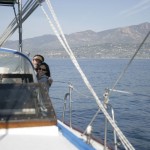
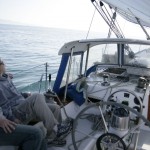
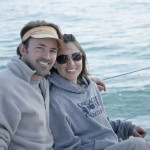
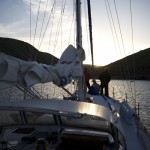
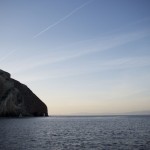
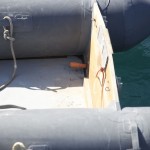
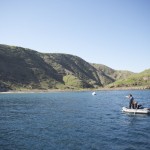
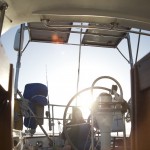
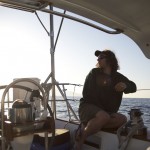
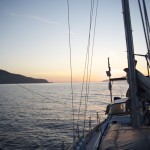
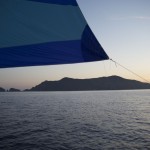
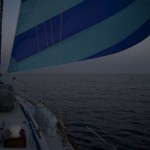
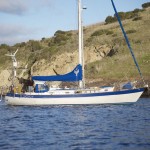
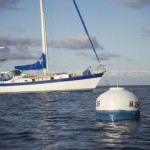
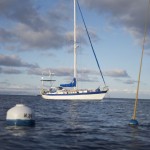
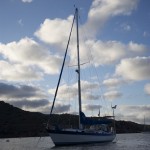
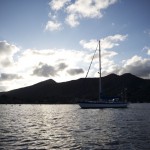
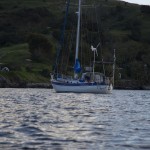
February 20th, 2010 at 3:15 pm
Yeah, the whole anchoring thing is tricky. I am no expert, but I think eventually you will be anchoring with the same efficiency (and absence of anxiety) as when you locate and set up camp in the wilderness. You will know what to look for, what to avoid, get a feel for when the anchor has a good hold… I once anchored parallel to shore and close enough that I could hit it by throwing a rock–simply to get out of the weather (bow and stern anchors). All the other boats were getting hammered by wind and waves for several days and we were very protected by the nearby cliff. And since our engine was not functioning most of the time we had to sail in and out of all our moorings. That would be a good thing to practice while your engine is working.
February 20th, 2010 at 11:22 pm
Pat’s and my first experience with anchoring was memorable, too. We were taking coastal cruising lessons out of Santa Barbara, and part of the course involved anchoring off one of the Channel Islands. The first night, we anchored bow and stern, but when it was time to raise anchor the next morning, the wind had shifted 90 degrees, making raising anchor really difficult. Our instructor was using words that I am sure sailing instructors are not supposed to use.
February 22nd, 2010 at 9:29 am
When we anchored in Pelican Bay on Santa Cruz Island, I was a bit nervous about how close we were to the cliffs and the other boats in the anchorage, especially after seeing how much chain Jim let out. Later we went ashore and hiked up the cliff, looking down at the anchorage from there gave me a whole different perspective, there was a lot more room around us than it appears to be from the water. The only problems we’ve had so far are from other boats dropping their anchor on top of ours, or worring about the boats that drop their anchors with only enough rode to hit bottom, somehow they get away with it, we just try to stay as far away from the other boats as possible.
Maybe we’ll catch up with you someday. Juanita